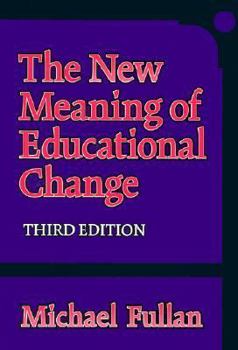The New Meaning of Educational Change
Select Format
Select Condition 
Book Overview
The book that revolutionized the theory and practice of educational change is now in its Fifth Edition Michael Fullan's The New Meaning of Educational Change is the definitive textbook on the study of... This description may be from another edition of this product.
Format:Hardcover
Language:English
ISBN:0807740691
ISBN13:9780807740699
Release Date:January 2001
Publisher:Teachers College Press
Length:297 Pages
Weight:0.85 lbs.
Dimensions:0.8" x 6.2" x 9.2"
Customer Reviews
5 ratings
Educational Reform
Published by Thriftbooks.com User , 15 years ago
I had to read this book for a class, but I have to say it was interesting. It has a lot of good information in the different chapters.
Clearly Written Text
Published by Thriftbooks.com User , 17 years ago
Fullan presents a well written account of educational change and the theories behind it. Well worth the read.
Educational Change in Concept
Published by Thriftbooks.com User , 18 years ago
Why the hell is it that the more things change, the more things seem to stay the same? Educational change expert Michael Fullan takes a crack at this proverbial school reform conundrum in the third edition of his book, The New Meaning of Educational Change. According to him, "Reform is not just putting into place the latest policy. It means changing the cultures of the classrooms, the schools, the districts, the universities, and so on. There is more to educational change than most people realize" (p. 7). Restructuring schools and education has been relatively simple, says Fullan; re-culturing them has not. For change to be substantive and long lasting, improving and strengthening relationships among various stakeholders is the key. Fullan divides his book into three parts: understanding educational change; change at the local level; and change at the global level. In the first part, he distinguishes between subjective and objective meanings of educational change, but in an awkward manner. Drawing from Dan Lortie's work on the sociology of teaching, his main argument is that teaching is a lonely profession without a well-developed shared technical culture, which leads invariably to widespread uncertainty, fragmentation, and haphazardness--all impediments to educational change. He does not explicitly describe the differences or importance of either concept, but leaves the reader with the ultimate impression that three dimensions undergird the implementation of change: "the possible use of... new or revised materials... teaching approaches... and the alteration of beliefs" (p. 39). According to Fullan, most educational reforms are ephemeral or shallow because they have grossly overlooked the importance of the third dimension (beliefs), unsurprisingly. He often distinguishes between change and the "process" of change with a 25/75 rule: educational change is 25% structural (ideas), 75% re-culturing (processes). Fullan uses the last two parts to provide insights about adoption and implementation of policies geared toward educational change through the lens of the various stakeholders involved (teacher, principal, parent, student, school board, etc.). He is careful not to make sweeping generalizations, and has a nose for local idiosyncrasies. His most pronounced clarion call, however, is for the scaling up of whole school reform and professional learning communities (the latter fits well with his claim that beliefs are the hardest dimension to alter). Shared meaning of educational change is only possible through allowing stakeholders more transparency into each other's roles and promoting more collaboration between groups. In each chapter, Fullan shores up his arguments with major research studies, and often expresses the findings axiomatically: For example, poorly performing schools showed "little or no attention to schoolwide problems" (p. 121). This is not a bad thing. It just makes the reader think, "Duh!?!?" Somewhat annoying was Fullan's tend
What is New in "The New Meaning of Educational Change"?
Published by Thriftbooks.com User , 22 years ago
The third edition of Fullen's book - "The New Meaning of Educational Change" came out to the readers in 2001 ten years after its second edition was published. Its contents have been greatly enriched and "`the meaning hypothesis' has become deeply confirmed." The "knowledge base" of change in this book is broadened and deepened by applying the advances of cognitive science and the chaos theory. Based upon this, the conclusion is made that "working on `coherence' is the key to dealing with the nonlinear fragmented demands of overloaded reform agendas". A variety of most recent research about educational innovations by Cohen, Elmore, Fullan, Hargreaves, Hatch, Oakes and other researchers are integrated into different chapters and themes. Some newly verified thoughts of educational change are also presented in the new book. For instance, "one of the keys to successful changes is the improvement of relationships-precisely the focus of group development," "you can turn around an elementary school in about 3 years, a high school in 6 years, and a school district (depending on size) in about 8 years." The new edition maintains the key structure and context of its former editions. Part one is concerned with understanding the overview of educational change. Part two are designed to look at change at the local level. Part three deals with educational change at the regional and national levels. The book remains its focuses on understanding both the small and big pictures of change and maintains the theme of rendering complexity understandable and amendable to productive action. The author's in-depth insights about the contradictory and paradoxical nature of change and his illustrative and practical ideas about the procedures of change still greatly contributes to the values of the book. If you want to equip yourself with the important, resourceful, and up-dated theory, research and practices about "what" and "how" of educational change, the third edition is your necessity.
The bible of educational change theory.
Published by Thriftbooks.com User , 24 years ago
This book is a must-read for anyone interested in school change and reform. Fullan has provided a comprehensive overview as well as a host of unique ideas. This was not intended to be a casual read. It is a serious reference.





